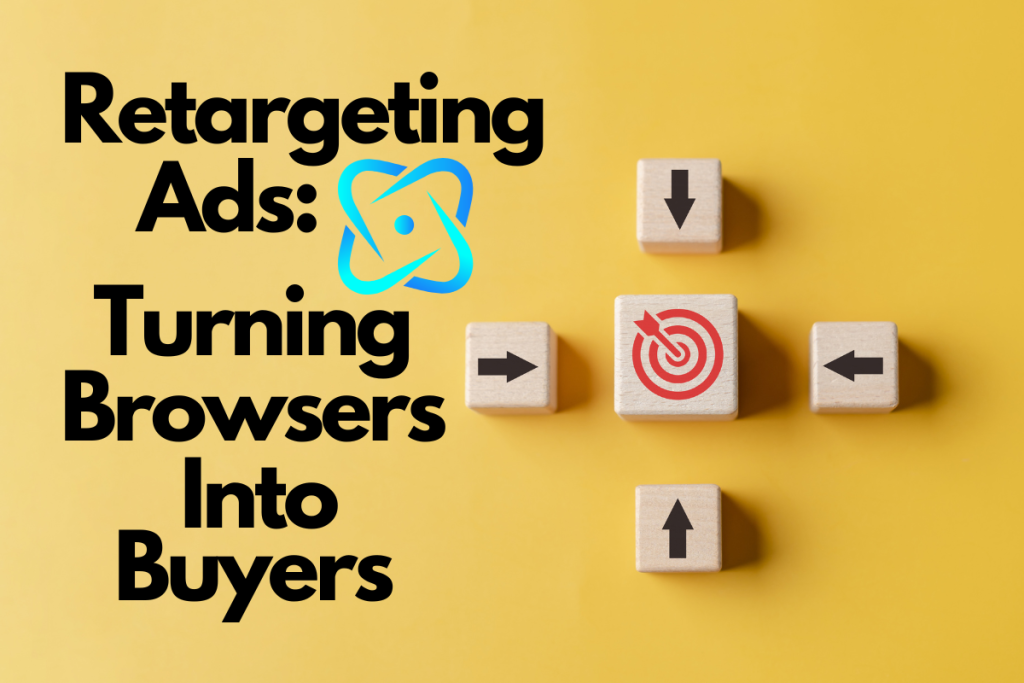Retargeting Ads: Turning Browsers into Buyers
In the fast-paced world of digital marketing, businesses are constantly seeking innovative strategies to convert website visitors into loyal customers. One such strategy that has proven to be highly effective is retargeting ads. This powerful tool allows marketers to re-engage potential customers who have already shown interest in their products or services but have not yet made a purchase. In this blog post, we will explore the ins and outs of retargeting ads, discuss their benefits, and provide actionable tips on how to leverage them effectively to turn browsers into buyers.

Retargeting Ads From My Personal Views
I know how frustrating it can be when you have someone visit your landing page but does not convert into a true paid customer. I experienced the same when I first started marketing one of my courses a few years back. At first I felt defeated but once I started to retarget ads specific to those prospects who had the interest to click into my landing page, it made a big difference in my success to convert lookers into buyers. Now I hope this will help those too whom are just starting out and are experiencing the same.
What are Retargeting Ads?
Retargeting ads, also known as remarketing ads, are targeted advertisements that are served to individuals who have previously interacted with your website or mobile app. These ads aim to re-engage users by reminding them of the products or services they showed interest in during their initial visit. By displaying relevant ads across various platforms, retargeting helps keep your brand top-of-mind and encourages potential customers to complete their purchase journey.
The Importance of Retargeting
Research conducted by AdRoll reveals that only 2% of first-time website visitors convert on their initial visit. Retargeting ads aim to capture the remaining 98% by strategically reaching out to these users as they browse other websites or social media platforms. By doing so, retargeting helps to increase brand recall, improve conversion rates, and ultimately boost sales.
How Do Retargeting Ads Work?
Retargeting ads utilize browser cookies to track users’ online behavior. When a user visits your website, a cookie is placed in their browser, allowing you to follow their journey across the internet. This data is then used to serve personalized ads to the user on various platforms, encouraging them to return to your website and complete their purchase.
Types of Retargeting Ads
There are two main types of retargeting ads: pixel-based and list-based. Let’s explore each of them:
Pixel-Based Retargeting
Pixel-based retargeting is the most common form of retargeting. It involves placing a small, unobtrusive piece of JavaScript code (a pixel) on your website. This pixel tracks visitors and records their interactions, enabling you to serve ads to them later. The biggest advantage of pixel-based retargeting is its immediacy, as ads can be displayed to users shortly after they leave your site.
List-Based Retargeting
List-based retargeting relies on a pre-existing list of contacts, such as email subscribers. This method is particularly useful for targeting specific groups of users with tailored messages. By uploading your contact list to a retargeting platform, you can serve ads directly to these users as they browse the web.
Benefits of Retargeting Ads
Retargeting ads offer numerous benefits that can significantly impact your marketing efforts. Here are some key advantages:
Increased Conversion Rates

Retargeting ads significantly enhance conversion rates by re-engaging users who have already shown interest in your brand. Studies show that retargeted ads lead to a 1046% increase in branded search and can improve conversion rates by up to 150%.
Improved Ad Relevance
Since retargeting ads are based on users’ previous interactions, they are highly relevant to their interests. This relevance increases the likelihood of users clicking on the ads and converting, as they are reminded of products they have already considered.
Cost-Effectiveness
Retargeting ads are typically more cost-effective than traditional advertising methods. By focusing your budget on users who have already expressed interest in your products, you can maximize your return on investment (ROI) and reduce wasted ad spend.

Best Practices for Effective Retargeting Ads
To make the most of your retargeting efforts, it’s essential to follow best practices that ensure your ads are both effective and engaging. Here are some tips to help you succeed:
Segment Your Audience
Segmenting your audience allows you to deliver highly personalized ads that resonate with different user groups. For example, you can create separate segments for users who abandoned their shopping cart, viewed specific product pages, or subscribed to your newsletter. Tailoring your ads to each segment increases their relevance and effectiveness.
Use Dynamic Ads
Dynamic ads automatically update to display products or services that users have previously viewed on your website. By showing users the exact items they were interested in, you can significantly increase the chances of conversion. Dynamic ads are particularly effective for e-commerce businesses with large product catalogs.
Set Frequency Caps
While retargeting ads are powerful, it’s crucial not to overwhelm users with excessive advertising. Setting frequency caps ensures that your ads are displayed a limited number of times to each user, preventing ad fatigue and maintaining a positive brand image.
Test and Optimize

Continuously testing and optimizing your retargeting ads is vital for achieving the best results. Experiment with different ad formats, messaging, and visuals to identify what resonates most with your audience. Use A/B testing to compare different variations and make data-driven decisions.
Real-Life Examples of Successful Retargeting Campaigns
To illustrate the effectiveness of retargeting ads, let’s explore some real-life examples of successful campaigns:
Case Study 1: Amazon
Amazon, the e-commerce giant, employs sophisticated retargeting strategies to drive sales. By leveraging users’ browsing and purchase history, Amazon serves personalized ads that showcase products users are likely to be interested in. This approach has contributed to Amazon’s impressive conversion rates and customer retention.
Case Study 2: Airbnb
Airbnb uses retargeting ads to remind users of their previous searches and encourage them to book accommodations. By highlighting unique listings and offering exclusive discounts, Airbnb effectively re-engages potential travelers and boosts bookings.
Conclusion: Harness the Power of Retargeting Ads

Retargeting ads are a game-changer in the world of digital marketing. By strategically targeting users who have already shown interest in your brand, you can significantly increase conversion rates, improve ad relevance, and maximize your ROI. Remember to segment your audience, use dynamic ads, set frequency caps, and continuously test and optimize your campaigns for the best results.
As you embark on your retargeting journey, keep these tips in mind and harness the power of retargeting ads to turn browsers into buyers. With the right strategy, you can boost your sales and achieve long-term success in the competitive digital landscape.



